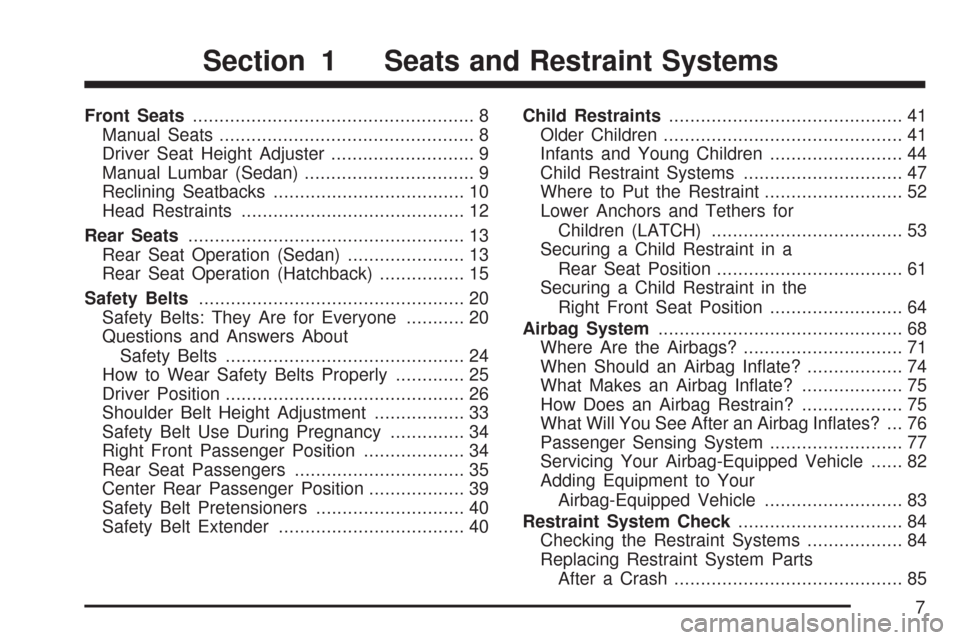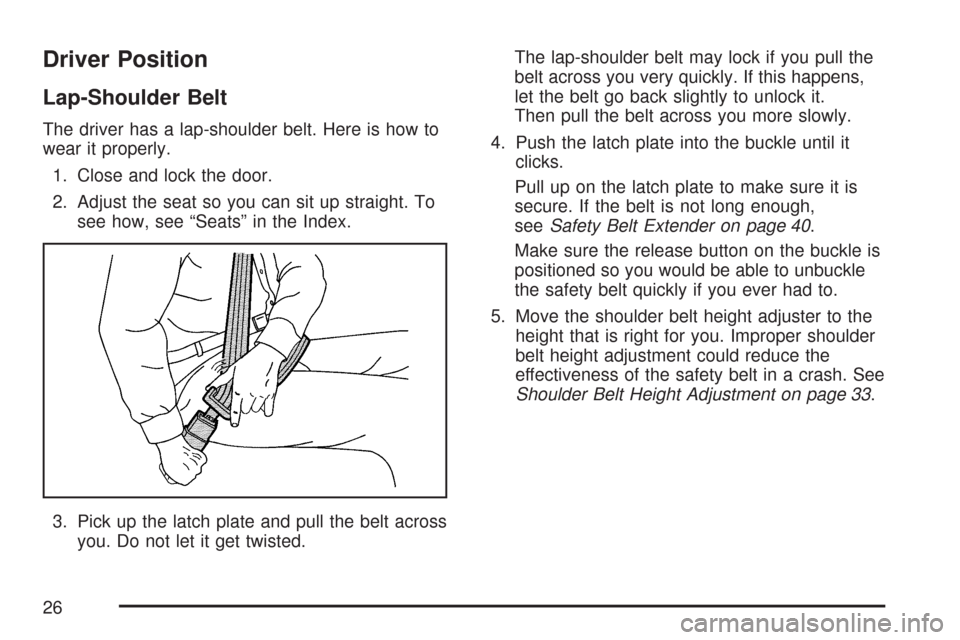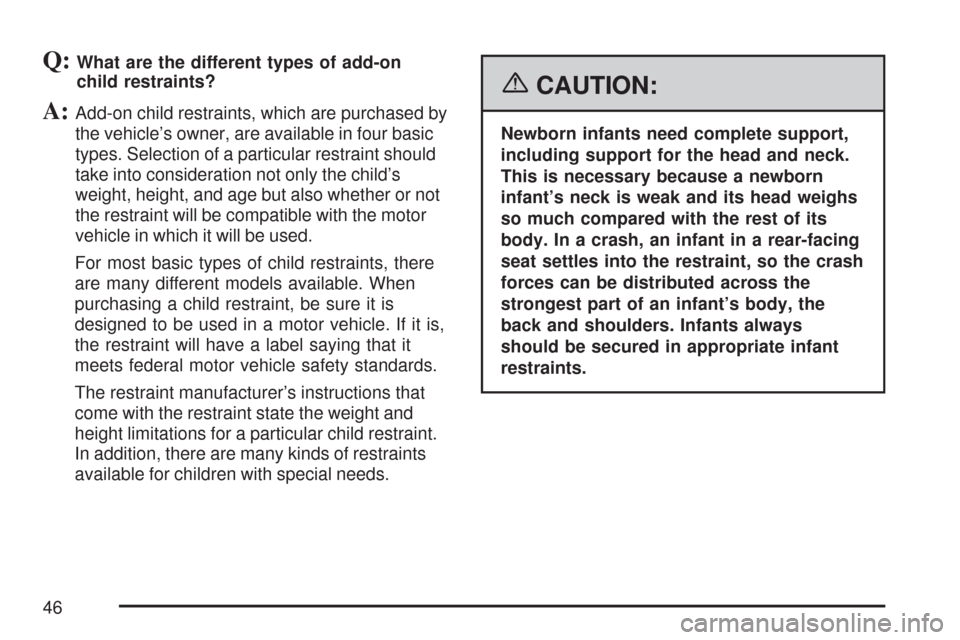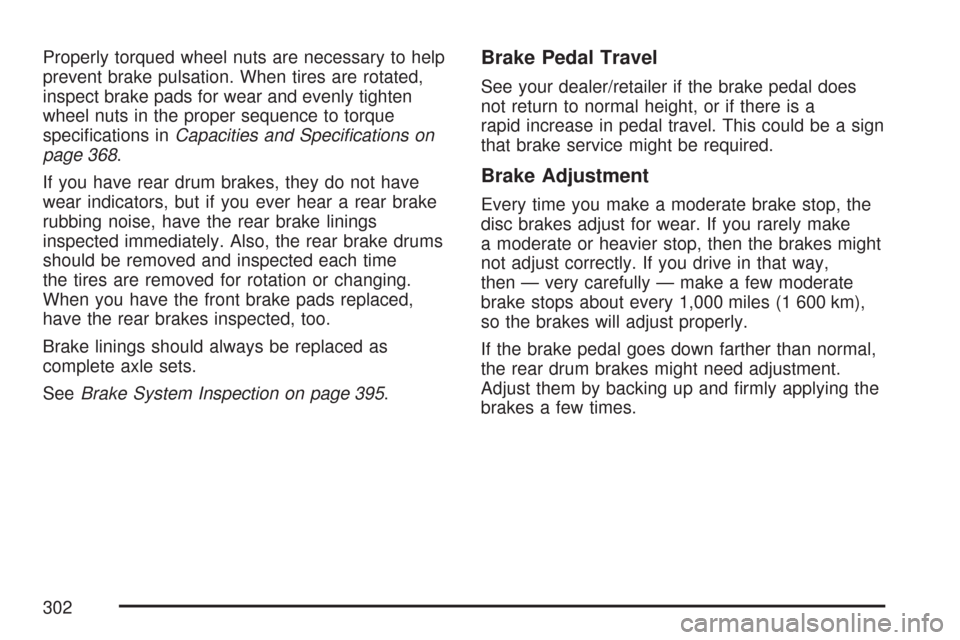Page 7 of 436

Front Seats..................................................... 8
Manual Seats................................................ 8
Driver Seat Height Adjuster........................... 9
Manual Lumbar (Sedan)................................ 9
Reclining Seatbacks.................................... 10
Head Restraints.......................................... 12
Rear Seats.................................................... 13
Rear Seat Operation (Sedan)...................... 13
Rear Seat Operation (Hatchback)................ 15
Safety Belts.................................................. 20
Safety Belts: They Are for Everyone........... 20
Questions and Answers About
Safety Belts............................................. 24
How to Wear Safety Belts Properly............. 25
Driver Position............................................. 26
Shoulder Belt Height Adjustment................. 33
Safety Belt Use During Pregnancy.............. 34
Right Front Passenger Position................... 34
Rear Seat Passengers................................ 35
Center Rear Passenger Position.................. 39
Safety Belt Pretensioners............................ 40
Safety Belt Extender................................... 40Child Restraints............................................ 41
Older Children............................................. 41
Infants and Young Children......................... 44
Child Restraint Systems.............................. 47
Where to Put the Restraint.......................... 52
Lower Anchors and Tethers for
Children (LATCH).................................... 53
Securing a Child Restraint in a
Rear Seat Position................................... 61
Securing a Child Restraint in the
Right Front Seat Position......................... 64
Airbag System.............................................. 68
Where Are the Airbags?.............................. 71
When Should an Airbag Inflate?.................. 74
What Makes an Airbag Inflate?................... 75
How Does an Airbag Restrain?................... 75
What Will You See After an Airbag Inflates? ... 76
Passenger Sensing System......................... 77
Servicing Your Airbag-Equipped Vehicle...... 82
Adding Equipment to Your
Airbag-Equipped Vehicle.......................... 83
Restraint System Check............................... 84
Checking the Restraint Systems.................. 84
Replacing Restraint System Parts
After a Crash........................................... 85
Section 1 Seats and Restraint Systems
7
Page 9 of 436
Driver Seat Height Adjuster
To adjust the height of
the driver’s seat
cushion, turn the knob
located on the outboard
side of the seat
cushion.
Turn the knob forward to raise the height of the
seat cushion and rearward to lower it.
Manual Lumbar (Sedan)
Your vehicle may have manually operated lumbar
support for the driver’s seat.
To adjust the front seat lumbar support, use the
lever located on the outboard side of the seatback.
Push the lever down to adjust the support for
the lower part of the seatback. Pull the lever up to
return the support to its original position.
9
Page 12 of 436
Head Restraints
Adjust the head restraint so that the top of the
restraint is at the same height as the top of
the occupant’s head. This position reduces the
chances of a neck injury in a crash.Pull the head restraint up to raise it. To lower it,
press the button, located on the top of the
seatback, and push the head restraint down.
The front seat head restraints also tilt forward. To
tilt the head restraint, first put it in the upright
position by tilting it forward fully and releasing it.
Then slowly move the head restraint forward until it
is in the desired position.
12
Page 26 of 436

Driver Position
Lap-Shoulder Belt
The driver has a lap-shoulder belt. Here is how to
wear it properly.
1. Close and lock the door.
2. Adjust the seat so you can sit up straight. To
see how, see “Seats” in the Index.
3. Pick up the latch plate and pull the belt across
you. Do not let it get twisted.The lap-shoulder belt may lock if you pull the
belt across you very quickly. If this happens,
let the belt go back slightly to unlock it.
Then pull the belt across you more slowly.
4. Push the latch plate into the buckle until it
clicks.
Pull up on the latch plate to make sure it is
secure. If the belt is not long enough,
seeSafety Belt Extender on page 40.
Make sure the release button on the buckle is
positioned so you would be able to unbuckle
the safety belt quickly if you ever had to.
5. Move the shoulder belt height adjuster to the
height that is right for you. Improper shoulder
belt height adjustment could reduce the
effectiveness of the safety belt in a crash. See
Shoulder Belt Height Adjustment on page 33.
26
Page 33 of 436
To unlatch the belt, push the button on the buckle.
The belt should go back out of the way.
Before you close the door, be sure the belt is out
of the way. If you slam the door on it, you can
damage both the belt and your vehicle.
Shoulder Belt Height Adjustment
Before you begin to drive, move the shoulder belt
height adjuster to the height that is right for you.
Adjust the height so that the shoulder portion of
the belt is centered on your shoulder. The
belt should be away from your face and neck, but
not falling off your shoulder. Improper shoulder
belt height adjustment could reduce the
effectiveness of the safety belt in a crash.
To move it down, press
the release button (A)
and move the height
adjuster to the desired
position.
After you move the height adjuster to where you
want it, try to move it down without pressing
the release button to make sure it has locked into
position.
33
Page 46 of 436

Q:What are the different types of add-on
child restraints?
A:Add-on child restraints, which are purchased by
the vehicle’s owner, are available in four basic
types. Selection of a particular restraint should
take into consideration not only the child’s
weight, height, and age but also whether or not
the restraint will be compatible with the motor
vehicle in which it will be used.
For most basic types of child restraints, there
are many different models available. When
purchasing a child restraint, be sure it is
designed to be used in a motor vehicle. If it is,
the restraint will have a label saying that it
meets federal motor vehicle safety standards.
The restraint manufacturer’s instructions that
come with the restraint state the weight and
height limitations for a particular child restraint.
In addition, there are many kinds of restraints
available for children with special needs.
{CAUTION:
Newborn infants need complete support,
including support for the head and neck.
This is necessary because a newborn
infant’s neck is weak and its head weighs
so much compared with the rest of its
body. In a crash, an infant in a rear-facing
seat settles into the restraint, so the crash
forces can be distributed across the
strongest part of an infant’s body, the
back and shoulders. Infants always
should be secured in appropriate infant
restraints.
46
Page 83 of 436

Adding Equipment to Your
Airbag-Equipped Vehicle
Q:Is there anything I might add to the
exterior of the vehicle that could keep the
airbags from working properly?
A:Yes. If you add things that change your
vehicle’s frame, bumper system, height,
front end or side sheet metal, they may keep
the airbag system from working properly.
Also, the airbag system may not work properly
if you relocate any of the airbag sensors. If
you have any questions about this, you should
contact Customer Assistance before you
modify your vehicle. The phone numbers and
addresses for Customer Assistance are in
Step Two of the Customer Satisfaction
Procedure in this manual. SeeCustomer
Satisfaction Procedure on page 402.
Q:Because I have a disability, I have to get
my vehicle modi�ed. How can I �nd out
whether this will affect my airbag system?
A:Changing or moving any parts of the
front seats, safety belts, the airbag sensing
and diagnostic module, steering wheel,
instrument panel, or airbag wiring can affect
the operation of the airbag system. If you have
questions, call Customer Assistance. The
phone numbers and addresses for Customer
Assistance are in Step Two of the Customer
Satisfaction Procedure in this manual.
SeeCustomer Satisfaction Procedure on
page 402.
Your dealer/retailer and the service manual have
information about the location of the airbag
sensors, sensing and diagnostic module and
airbag wiring.
83
Page 302 of 436

Properly torqued wheel nuts are necessary to help
prevent brake pulsation. When tires are rotated,
inspect brake pads for wear and evenly tighten
wheel nuts in the proper sequence to torque
specifications inCapacities and Specifications on
page 368.
If you have rear drum brakes, they do not have
wear indicators, but if you ever hear a rear brake
rubbing noise, have the rear brake linings
inspected immediately. Also, the rear brake drums
should be removed and inspected each time
the tires are removed for rotation or changing.
When you have the front brake pads replaced,
have the rear brakes inspected, too.
Brake linings should always be replaced as
complete axle sets.
SeeBrake System Inspection on page 395.Brake Pedal Travel
See your dealer/retailer if the brake pedal does
not return to normal height, or if there is a
rapid increase in pedal travel. This could be a sign
that brake service might be required.
Brake Adjustment
Every time you make a moderate brake stop, the
disc brakes adjust for wear. If you rarely make
a moderate or heavier stop, then the brakes might
not adjust correctly. If you drive in that way,
then — very carefully — make a few moderate
brake stops about every 1,000 miles (1 600 km),
so the brakes will adjust properly.
If the brake pedal goes down farther than normal,
the rear drum brakes might need adjustment.
Adjust them by backing up and firmly applying the
brakes a few times.
302